World War II
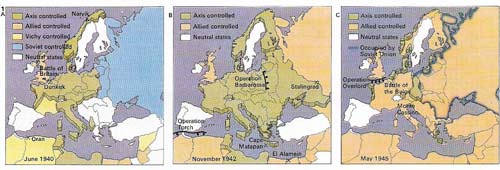
Figure 1. The main theater of war was in Europe, as it was in World War I. (A) By June 1940 the Axis powers controlled almost the whole of Western Europe and Germany then broadened the conflict by attacking the Soviet Union a year later. (B) Axis conquests reached their peak in November 1942. (C) By May 1945 Russian counteroffensives and Allied landings in France and Italy had defeated Germany.

Figure 2. Increasingly sophisticated weapons appeared as the war progressed. (A) Mastery of tank warfare gave the Germans their initial successes. (B) Heavy bombers carried death and destruction deep into the German homeland but failed to break civilian morale. (C) The Allies then had to invent and perfect the techniques of amphibious warfare in order to invade "Fortress Europe".
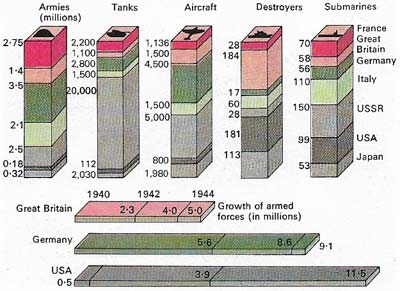
Figure 3. This comparison of military power at the outbreak of war shows that, although Germany had more aircraft in 1939, France and Britain together were in fact stronger in men and equipment. The vast size of the Soviet forces shows how advantageous the Stalin-Hitler pact was to Germany. Manpower was needed on a massive scale and the lower half of the diagram shows the growth in armed forces, which was particularly appreciable in the United States.
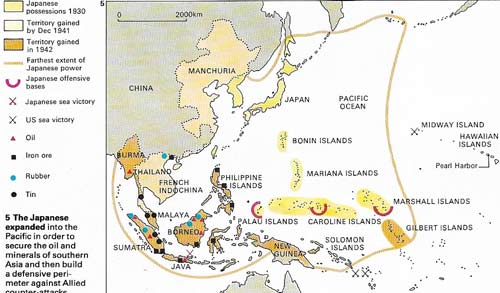
Fig 4. The Japanese expanded into the Pacific in order to secure the oil and minerals of southern Asia and then build a defensive perimeter against Allied counter-attacks.
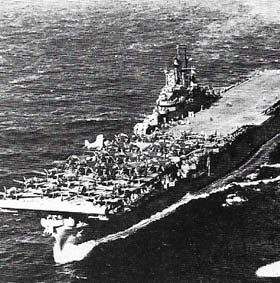
Figure 5. The Allied counter-offensive in the Pacific depended largely on a unique naval campaign in which carrier-borne aircraft played a decisive role. Quickly mastering this new type of warfare, the US Navy was able to destroy the Japanese fleet, bypass enemy held islands, and cut off Japan from its vital supplies. Major land campaigns took place only in Burma and the Philippines.
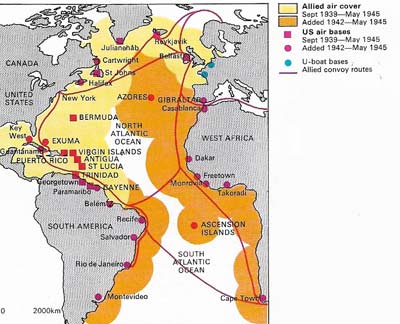
Figure 6. The Battle of the Atlantic was a crucial one for Britain once the threat of a German invasion had been removed. The German U-boats hoped to starve Britain into submission, thus eliminating the possibility of a counter-attack in the west. In 1941–1942 the U-boats almost succeeded in their aim, and it was not until anti submarine measures had been intensified and improved that the U-boats were eventually mastered.

Figure 7. Hiroshima was devastated by the first atomic bomb. By later standards this was a very small bomb of less than one kiloton, but was enough to obliterate an entire city and killed more than 78,500 people in the space of one minute. A new era of warfare threatening total annihilation had been unleashed on mankind.
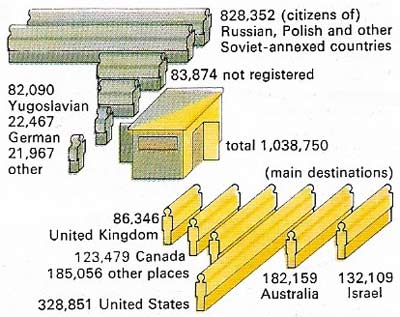
Figure 8. By the end of the war more than a million displaced persons were living in refugee camps throughout Europe. The majority were Soviet citizens or citizens of countries annexed by the USSR. The diagram shows where the east European refugees came from and where the International Refugee Organisation succeeded in settling them.
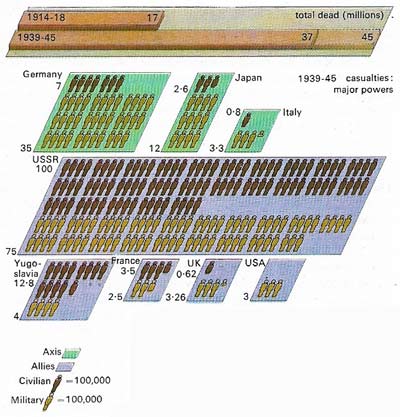
Figure 9. World War II was the most destructive and wide-ranging war in history: the dead may have totaled 45 million. Military casualties were only slightly higher than in World War I, but massive bombing and German policies against civilians in the occupied territories meant that civilian deaths were far higher.
On 1 September 1939, German troops invaded Poland. Britain and France were pledged to support Poland and declared war on Germany two days later. Using revolutionary Blitzkrieg ("lightning attack") tactics the Germans defeated the outdated Polish army in 18 days and the country was partitioned between Germany and the Soviet Union, with whom Germany had just signed a non-aggression pact. A British army crossed to France but did not attack, and a "phoney war" lasted until the spring.
German and Japanese victories
Germany overran Norway and Denmark in April 1940 and then on 10 May invaded Holland, Belgium, and Luxembourg, which had been neutral. As the Allied armies swung forwards to meet them German tanks burst through the "impassable" Ardennes and reached the English Channel. The Allied army to their north was forced back into the Dunkirk region, and 338,226 British and French troops escaped to England by sea between 29 May and 3 June. Most of France, except for the southeast under the puppet Vichy regime of Henri Main (1856–1951), was occupied by the Germans.
Germany's leader, Adolf Hitler (1889–1945), expected Britain to make peace, but she fought on defiantly under the leadership of Winston Churchill (1874–1965). The Luftwaffe (air force) of Hermann Goering (1893–1946) then attempted to destroy the Royal Air Force (RAF) so that an invasion of England could be launched. But the Germans were defeated in the Battle of Britain fought between August and October 1940.
Taking advantage of the French Atlantic ports, German submarines intensified their attacks on British sea routes and in the next two years came near to strangling Britain (Figure 6). Italy entered the war in June 1940 but suffered serious defeats in Greece and Libya. Germany sent forces under General Erwin Rommel (1891–1944) to help the Italians in North Africa and swiftly overran Yugoslavia, Greece and Crete in April and May 1941.
On 22 June 1941, in breach of the earlier pact, German troops swept into the Soviet Union, achieving total surprise. After five months they were just 30 kilometers (19 miles) from Moscow but were halted by bitter winter weather and stubborn Russian resistance. On 7 December 1941, in the second major onslaught of the war, Japan launched a surprise attack on the US fleet at Pearl Harbor.
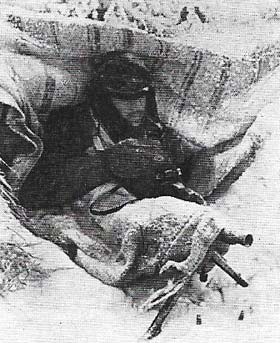 |
| The turning-point of the war in Europe came when Hitler attacked the Soviet union in 1941 and failed to deliver a swift knockout blow. The key battle took place at Stalingrad where, after weeks of frozen siege, the German 6th Army was forced to surrender. Germany was committed to a war on two fronts, with a possible counter-attack from Britain in the west and a war of attrition against the vast Russian reserves available in the east. |
The first half of 1942 saw the Axis forces (Germany, Italy, Japan, and minor allies) at the height of their powers. In the Pacific the Japanese captured the Dutch East Indies, Malaya, Burma, the Philippines, and many Pacific islands (Figure 4). In the Soviet Union a German offensive advanced on Stalingrad and the Caucasus. In North Africa the British had been driven back to the borders of Egypt.
The turn of the tide
A series of crucial battles later in 1942 and in 1943 gave the initiative to the Allies. In the Pacific, Japanese naval power was shattered at the Battle of Midway on 4–7 June 1942; and on 7 August US marines landed in Guadalcanal in the first of the amphibious assaults by which US naval power under Admiral Chester Nimitz (1885–1966) pushed back the Japanese. In bitter weather in the Soviet Union 110,000 men of the original German army of 270,000, fighting at Stalingrad, surrendered on 31 January 1943. The remaining 160,000 men had been killed. In North Africa the victory of General Bernard Montgomery (1887–1976) at El Alamein in October 1942, and an Allied landing in Algeria, forced the Axis troops back into Tunisia where 250,000 surrendered on 12 May 1943. In the Atlantic, Allied sonar and radar, more escorts and long-range aircraft led to increased U-boat losses.
The beginning of the end
The last major German offensive in the Soviet Union was halted at Kursk in July 1943 and the Red Army pushed forward during the autumn and winter. The Allies under Field-Marshal Harold Alexander (1891–1969) invaded Sicily on 10 July 1943 and landed in Italy on 3 September. The RAF had made its first "1,000-bomber" raid on Germany in May 1942 and, with the arrival of the United States Army Air Force in mid-1943, massive day and night raids were mounted for the rest of the war.
On D-Day, 6 June 1944, Allied forces under General Dwight Eisenhower (1890–1969) landed in Normandy and crossed France and the Low Countries to reach the Rhine by November. In Italy, Rome had been captured on 4 June, while a Soviet offensive begun in the same month drove the Germans out of the Soviet Union and swept into Poland and the Baltic states. In the Pacific, American forces destroyed the remnants of the Japanese fleet at the battles of the Philippine Sea and Leyte Gulf, and invaded the Philippines in October 1944. In Burma, the British defeated a Japanese attempt to invade India and counter-attacked successfully.
The Allies crossed the Rhine in March 1944 and drove deep into Germany. A Soviet assault under Marshal Georgi Zhukov (1896–1974) began in January 1945 and reached Berlin in April. Hitler committed suicide and on 4 May Germany surrendered.
On 6 August US forces dropped the first atomic bomb on Hiroshima, Japan (Figure 7). A second bomb on Nagasaki forced Japan to surrender on 14 August 1945.
